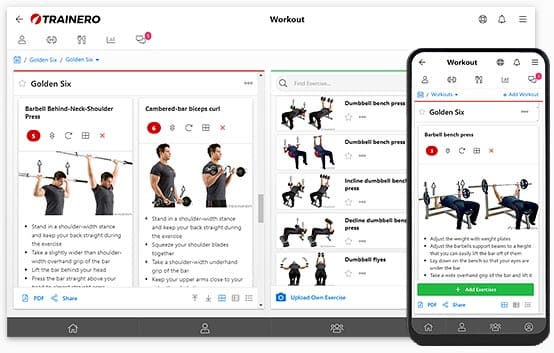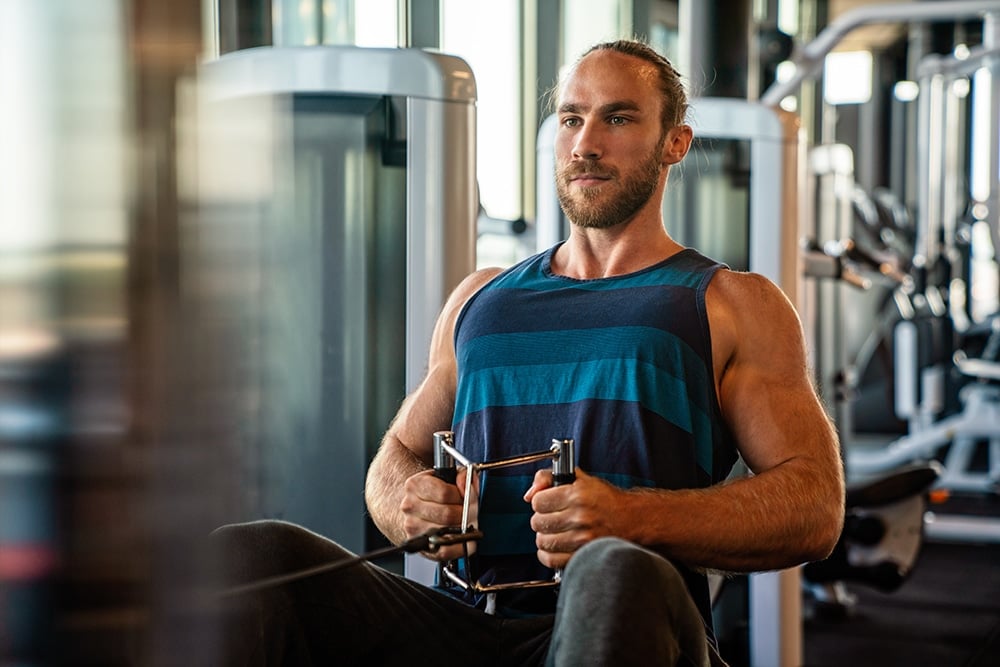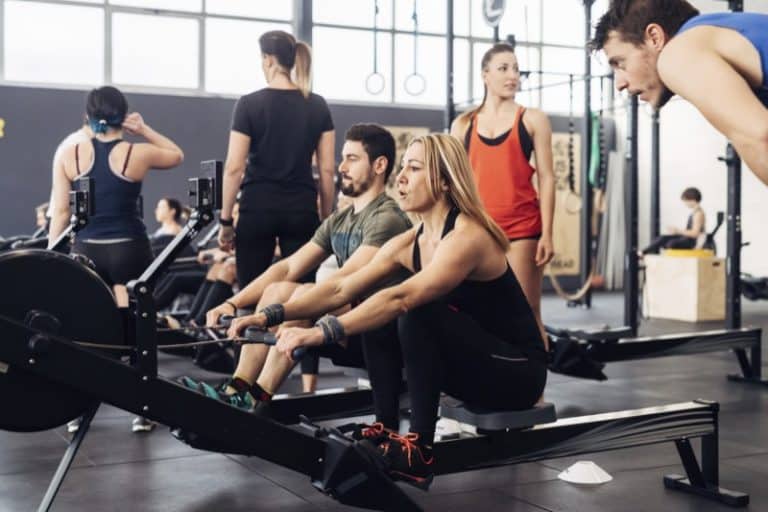Workout Routine: Build Muscle & Hypertrophy
Building muscle and achieving hypertrophy are central goals for many fitness enthusiasts, from beginners to advanced lifters. A well-structured workout routine can make all the difference in reaching your fitness goals. In this article, we will explore effective workout plans, the best exercises for muscle growth, and the importance of proper form, all while emphasizing the principles of hypertrophy training. Whether you’re just starting out or looking to optimize your advanced workout, this comprehensive guide will help you step your training up a notch.

Unlock your fitness potential with Trainero! Get a 14-day free trial and access personalized workout plans, expert coaching, and progress tracking—all in one app. No commitments, just results. Start your free trial today and take your fitness journey to the next level!

What is a Workout Plan for Beginners to Build Muscle?
Essential Components of a Beginner Workout Routine
For beginners looking to build muscle, a well-crafted workout plan is essential. At the core, a beginner workout routine should include a balance of compound exercises and isolation movements. Compound exercises such as squats, bench presses, and deadlifts engage multiple muscle groups, allowing beginners to maximize their workout efficiency. These exercises not only help in building muscle mass but also promote overall strength and stability. A typical workout week for a beginner might consist of three to four sessions, focusing on different muscle groups each day, ensuring adequate recovery time between workouts.
Choosing the Right Exercises for Muscle Growth
When selecting exercises for muscle growth, it is vital to prioritize movements that target major muscle groups. For the upper body, exercises like the bench press and dumbbell curls can effectively stimulate the chest, triceps, and biceps. For the lower body, squats and lunges are excellent for developing the quadriceps, hamstrings, and calves. A well-rounded workout plan should also include bodyweight exercises and resistance training to enhance overall fitness and functional strength. Incorporating a variety of exercises keeps the routine engaging and helps prevent plateaus in muscle growth.
How to Structure Your Workout Schedule
Structuring your workout schedule is crucial for consistency and progress. A beginner may benefit from a three-day split routine, focusing on different muscle groups each day. For instance, Day 1 could concentrate on the upper body, Day 2 on the lower body, and Day 3 on full-body workouts. It is essential to allow at least one day of rest between sessions targeting the same muscle group to facilitate recovery and avoid the risk of injury. As you progress and build lifting experience, gradually increasing the volume of sets and reps can help enhance muscle and strength gains.
What Are the Best Exercises for Hypertrophy in Advanced Lifters?
Key Muscle Groups for Advanced Workout Programs
For advanced lifters, understanding the key muscle groups is paramount when designing a workout program to achieve hypertrophy. Focusing on major muscle groups like the chest, back, legs, and shoulders can lead to significant gains. Advanced workout programs often incorporate a mix of compound exercises and isolation exercises, allowing lifters to target specific muscles while still engaging entire muscle chains. For instance, while the bench press works the chest, incorporating triceps extensions can further isolate and develop the triceps for a more defined upper body physique.
Integrating Compound and Isolation Exercises
Integrating both compound and isolation exercises is essential for maximizing hypertrophy. Compound exercises, such as deadlifts and squats, should form the foundation of any advanced workout routine, as they promote overall strength and muscle building. However, isolation exercises like bicep curls, tricep pushdowns, and calf raises are equally important for targeting specific muscle groups and enhancing aesthetics. The combination allows advanced lifters to work on both strength and detail, ensuring a balanced physique and contributing to overall muscle growth.
Importance of Progressive Overload for Muscle Building
Progressive overload is a fundamental principle in strength training that is critical for muscle building. For advanced lifters, this means continuously challenging the muscles by increasing resistance, volume, or intensity in workouts. Whether it’s adding weight to your barbell during squats or increasing the number of reps in your bench press, progressive overload is essential for stimulating muscle adaptation and growth. Tracking your workouts and making incremental adjustments can help ensure you are consistently pushing your limits and achieving the desired hypertrophy.
How to Create an 8-Week Workout Program for Muscle Building?
Setting Fitness Goals and Tracking Progress
Creating an effective 8-week workout program begins with setting clear fitness goals. Whether you aim to increase muscle mass or improve your overall physique, writing down your objectives can provide motivation and direction. Tracking your progress is equally important; maintaining a workout log can help you monitor changes in strength, endurance, and muscle size. By regularly assessing your performance, you can make necessary adjustments to your routine and ensure that you remain on a path toward reaching your fitness goals.
Weekly Schedule: Balancing Volume and Recovery
A well-structured weekly schedule is crucial for achieving muscle building results. An effective 8-week program might consist of a split routine with four to five workouts per week, incorporating various exercises targeting different muscle groups. Balancing workout volume with recovery is key; advanced lifters should ensure they are not overtraining, which can hinder muscle growth and increase the risk of injury. Allowing for recovery days and alternating intensity levels throughout the week can optimize your training and enhance results.
Adjusting Your Routine for Advanced Level Lifters
As you progress into the advanced level, adjusting your routine becomes imperative. Advanced training should involve more sophisticated techniques such as supersets, drop sets, and varying rep ranges to continually challenge the body. For instance, integrating sets of 8-12 reps for compound exercises and higher reps for isolation movements can provide a perfect blend of strength and hypertrophy. Additionally, focusing on adding weight and progressively increasing the challenge will ensure that muscle growth remains a primary objective throughout your training program.
What Role Does Proper Form Play in a Workout Routine?
Common Mistakes to Avoid in Strength Training
Proper form plays a critical role in the effectiveness of any workout routine. Common mistakes in strength training, such as improper lifting technique or neglecting core stability, can lead to suboptimal results and increase the risk of injury. For instance, rounding the back during a deadlift or letting the knees cave in during a squat can compromise safety and hinder muscle engagement. By focusing on maintaining proper form throughout your workouts, you can maximize muscle activation and prevent setbacks due to injuries.
Benefits of Focusing on Proper Technique
Focusing on proper technique offers numerous benefits that extend beyond just avoiding injury. When you use the correct form during exercises, you ensure that the targeted muscle groups are effectively engaged, leading to better muscle growth and improved performance. Additionally, mastering proper technique can boost your confidence while lifting heavier weights, as well as enhance your overall workout experience. As you become more familiar with the mechanics of each exercise, you’ll also find that your strength and endurance improve, allowing for more efficient workouts.
How to Improve Your Form for Key Exercises
Improving your form for key exercises is a continuous journey that requires dedication and self-awareness. One effective strategy is to use lighter weights or bodyweight exercises initially, allowing you to focus on mastering the movements without the added challenge of heavy lifting. Utilizing mirrors or recording your workouts can also provide valuable feedback on your technique. Additionally, seeking guidance from experienced lifters or a certified trainer can help identify areas for improvement and instill best practices in your workout routine.
How Everyone Can Optimize Their Workout Description for Muscle Growth?
Understanding the Principles of Hypertrophy Training
Everyone who is seeking to optimize their workout description for muscle growth should have a solid understanding of the principles of hypertrophy training. Hypertrophy is primarily stimulated through mechanical tension, muscle damage, and metabolic stress. To achieve this, incorporating a mix of high-intensity workouts with varying rep ranges, such as performing 8-12 reps for compound exercises and 12-15 reps for isolation movements, can create the necessary conditions for muscle growth. Committing to these principles consistently will lead to sustainable results.
Using Different Rep Ranges for Maximum Gains
Utilizing different rep ranges is a vital strategy for maximizing gains in muscle mass and strength. While traditional hypertrophy rep ranges of 8-12 reps are effective for building muscle, incorporating lower rep ranges (4-6 reps) for strength-focused lifts and higher rep ranges (15+ reps) for endurance can enhance muscle fibers and improve overall performance. This varied approach not only keeps workouts engaging but also ensures comprehensive development across all muscle groups, resulting in a well-rounded physique.
Nutrition Tips to Complement Your Workout Program
Nutrition plays a vital role in supporting any workout program focused on muscle growth. To maximize training results, it’s important to follow a balanced diet that includes plenty of protein, healthy fats, and complex carbohydrates. Sufficient protein intake is essential for muscle repair and growth, while carbohydrates provide the energy needed for intense workouts. Additionally, staying hydrated and timing meals around workouts can optimize performance and recovery. By aligning nutrition with your workout routine, you can effectively support your goals and enhance overall muscle building.

Unlock your fitness potential with Trainero! Get a 14-day free trial and access personalized workout plans, expert coaching, and progress tracking—all in one app. No commitments, just results. Start your free trial today and take your fitness journey to the next level!











